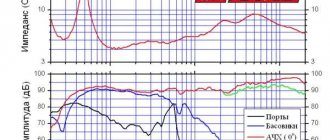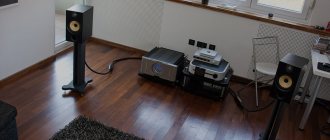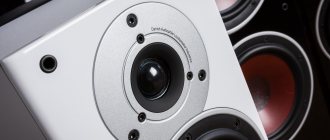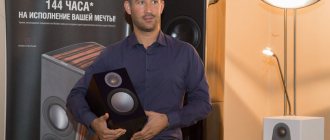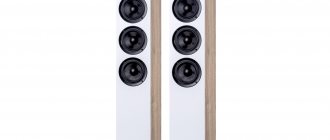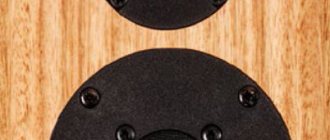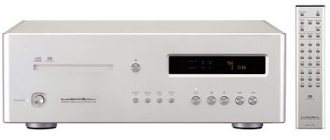DALI Zensor 3
princess.ofmusic, 03/09/2016
Advantages: Excellent acoustics. Beautiful soft sound, characteristic of these materials of the diffuser and tweeter. Very good in sound detail. The sound is natural and realistic. The sound is balanced, the wide bass does not drown out the mids and highs. The price justified every ruble invested. The highest price/quality ratio. We beat the magnificent Heco Music Style 200, which are cheaper than 300Eur versus 420Eur Zensor 3 (In the USA now Dali Zensor 3 is sold for $600, in Japan for $800). Acoustics are purchased and serve for decades, and savings here fade into the background, especially if you buy market leaders in speakers, which include the Dali Zensor 3. Just don’t turn the volume up to 100%, in extreme operating modes, this is not a music center competently assembled by specialists , a self-selected amplifier can burn out tweeters, I’m surprised how many people here burn out acoustics, and then get surprised and blame the manufacturers. The remaining 50 photos of Dali Zensor 3: https://fotki.yandex.ru/next/users/princess-ofmusic/album/205446/view/1678242
Disadvantages: In general, there are none. The red color of the speaker is somewhat reminiscent of cheap high-power stereos for teenagers, I use them with a grill. The rear bass reflex does not matter to me, since the microsystem from the Denon RCD-M39 series, praised by magazines and the best in user ratings, has rather weak, simplified, poorly developed bass, so the FI did not even have to be sealed, they stand 1 cm from the wall (only for wires space) and there is no buzzing or buzzing. When tested with bass amplifiers, Zensor 3 amazed with the beauty and power of the bass, I didn’t even want to disconnect it. In general, even with the Denon RCD-M39 the sound is relatively rich, but sometimes you want more (bass stereo 2.0 without subwoofer). No bi-wiring/bi-amping? Isn’t this a waste of money for two-way bookshelf speakers, like the gold-plated dome of the competitor Monitor Audio Bronze 2? Good acoustics sound great even without wiring-ampings. In general, I rarely listen to hard genres, mostly melodic and musical, here Zensor 3 are good, and on JBL rock sounds more aggressive and assertive, so it’s all a matter of taste. The high frequencies in comparison with the Heco Music Style 200 are raised by 1-2db, after the Heco the highs seemed a little harsh to me, the Heco equalizer was set at +2db (although they sometimes write that the Heco highs are raised (and this is true from the frequency response diagram and by ear, but I want it brighter), having set the treble to 0db with Dali Zensor 3, the sharpness of the treble completely disappeared, just as much for my ears, however, this may be the result of not yet completely warming up (doubtful) or the density of the Heco bass dampens the treble more. Against the background of the bass of the Zensor 3 , the high frequencies are audible better. On the frequency response diagram of Zensor 1, the highs from about 5-7 kHz and then grow upward by +3-+5db, I did not find the frequency response of Zensor 3 on the Internet.
Comment: I really wanted to buy it, my 7th Hi-Fi speaker. I bought it specifically for the Denon RCD-M39 with the goal of making the Hi-Fi microphone sound wider, similar to a real amplifier (Yamaha NS-6490, having excellent sound breadth, loses in sound purity to other speakers, Focal Chorus 705 has the same tight bass as Denon, JBL ES30 is a bit harsh for the sonorous Denon, Magnat MS202 and Chario are busy, Heco Style 200 was a good fit, but Zensor 3 is better in this case). If you choose between Heco Music Style 200 and this Dali, then you can note the following: the sound of both models is similar - soft, warm, typical for cellulose and silk, of the biggest differences, some clear superiority of Dali in detail is noticeable. Surprisingly, in terms of the perception of bass of Heco 200 practically do not lose to Zensor 3, Zensor are capable of a slightly lower range, but they give a slightly less dense, but more extensive bass (due to the slightly larger size of the Zensor 3), the Heko bass is a little denser, no less weighty, well drawn and what’s better is this It’s a matter of taste and mood, paired with the Denon RCD-M39, the censors are a little better at correcting its tight bass designed for the kitchen. That’s what I hear. In general, of course, listen with your own ears, this is just my opinion.
Completely different
The first thing that distinguishes the Oberon series from absolutely all previously released DALI speakers is, of course, the design, or rather, fashionable grills with rounded corners, covered with rough fabric in a vintage style. We have not yet been shown such DALIs. And what a bleached oak colored building with a white facade looks like - a sight for sore eyes! The only pity is that the grills are attached in the old fashioned way and leave behind four round black holes on the front panel, to which the eye inevitably catches. If it weren’t for this annoying fact, it would have turned out absolutely luxurious, but otherwise it’s just very good. A bonus to all this beauty is the competent selection of finishing materials, which, despite their simplicity, do not create a feeling of cheapness, as well as almost impeccable workmanship with precise fitting of parts and the famous branded DALI screws, ideally seated in the holes of the speaker flanges.
Oberon 3 looks especially interesting in light colors
However, not only the appearance, but also the design of Oberon has little in common with the retired Censors. The new product was literally developed from scratch. However, it cannot be said that these speakers were created from scratch. The historical roots of the Oberon series can be traced, but you need to look not at the bottom, but at the top of the line. After all, it is from there that the most advanced technologies get into the junior series. From their older brothers - Rubicon and Opticon - the new Oberon received two important technological solutions at once: the magnetic system of SMC midrange/woofers and an enlarged tweeter with an ultra-light fabric dome.
The inside of the speaker looks no less solid than the outside
Who would have thought that screws could be the subject of serious development?
As a result, Oberon is the most affordable model in the line, featuring a proprietary magnetic system, which most recently was the exclusive privilege of older series. The design of SMC speakers, as well as other proprietary DALI technologies, has been discussed more than once; I will not repeat myself and will remind you of the main features.
The use of soft magnetic material (SMC) in the design of midrange/bass drivers minimizes audible distortion. In practice, this is expressed primarily in a more transparent, clean and detailed sound of mid frequencies. The midrange/bass driver diffuser in Oberon models is made of a paper composite that combines cellulose fibers of different sizes: small fillers and large reinforcing ones. This approach has not changed for a long time, but the diffusers of the budget series had a slightly different appearance, a simpler texture and, apparently, lower density. The diffusers used in the Oberon series, both visually and in terms of density, are more reminiscent of older models.
Large 29mm dome fits well with large woofer
7-inch caliber is no joke! It barely fits on the façade
The large 29mm fabric dome is a means of expanding the effective operating range of the tweeter, allowing it to work more confidently at the interface with the mid/bass driver and making this interface seamless and imperceptible to the ear. And here it is worth paying attention to one more detail concerning the Oberon 3 model specifically. Being quite large bookshelf speakers, they are equipped with large midrange/bass diffusers of a non-standard caliber of 7 inches (178 mm). And a 29 mm tweeter in this case is the optimal solution.
Expectations and reality
The internal volume of more than 20 liters and the solid size of the midrange/bass speaker in a bass reflex design give one the right to expect quite solid sound from the Oberon 3. And this is already interesting. However, there is also cause for concern. For their overall dimensions, the weight of the speakers is more than modest. This is because the developers decided to ensure the acoustic inertness of the body not by increasing mass, but by combining high-density MDF, stiffeners and vibration-damping mats. The theory is clear, but did it work in practice?
The reverse side is not so magnificent, but if you wish, you can see in this not a cheapening of the design, but a vintage style
From the first notes, Oberon 3 showed a good claim to success. They met expectations in terms of the low-frequency range, delivering decent bass depth and a fairly sound picture, like small floor-standing speakers. At the same time, the worst expectations were not met - there are no box overtones even at high volumes. The bass reflex, pumping liters of air mass, also showed itself on the positive side already at medium volume. It did not produce any audible artifacts and generally attracted minimal attention to itself.
Vinyl film very convincingly imitates the texture of wood
If we talk about sound in general, Oberon 3 is a worthy keeper of the DALI family traditions. This model successfully combines detail, good tonal balance and timbral richness with a comfortable and expressive presentation of musical material. The stage is built wide and large-scale, with good elaboration of space. At the same time, the speakers are unpretentious in rotating the radiation axis in the horizontal plane; they do not have to be directed at the listening point; parallel orientation of the radiation axes gives perhaps the best result. Oberon 3 is a little more capricious in terms of installation height. For the best focus of the stereo image and the most accurate transmission of the sizes and proportions of sound images, you need to try to equalize the height of the ears and tweeters.
Neat rubber sticker feet included
The expressive sound of midrange frequencies with natural reproduction of the timbres of voices and live instruments goes well with shelf-fast and clear, but floor-deep bass. All this encourages long and thoughtful listening to jazz, rock and blues. Oberon 3 copes equally well with the stolid passages of Norah Jones and the furious pressure of Rage. Modern pop music represented by Dua Lipa and LP was also very good - rhythmic, bright, textured.
Yes, yes, these are branded DALI racks
Given a decent source and amplifier, these speakers seem versatile and self-sufficient. You might want something more on some electronic dance music tracks. This is that rare moment when the thought arises of the need to connect a subwoofer. Imperfections in terms of detail and completeness of timbre reproduction can only be revealed in complex Hi-Res quality recordings. But the pricing policy does not allow us to make any claims in this regard. Oberon 3 earns its money with a good margin. And most importantly, these speakers deliver audiophile and music lover pleasures in equal parts.
